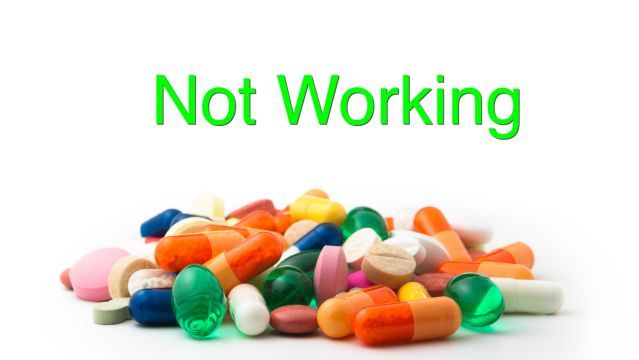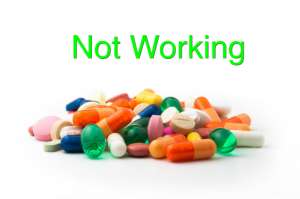
Antibiotic resistance has been named as a worldwide health catastrophe. Since the invention of antibiotics in the 1920s, scientists have found that bacteria become resistant to the drugs. This has spurred the continual creation of new antibiotics to battle the ever-evolving bacteria. It’s a vicious cycle of microbe versus medicine.
Recently this problem has come to the fore, as the medical industry is struggling to bring out new drugs that can kill the resistant bacteria. In fact, there has been a dry spell in new antibiotics since the 1980s.
How serious is antibiotic resistance?
In 2013, a report from the Centers for Disease Control and Prevention (CDC) indicated that over 2 million people in the United States get sick every year due to antibiotic-resistant bacteria, of which 23,000 die.
A recent report from the World Health Organization (WHO) evaluated the extent of the problem on a global scale. They reported that resistance to common bacteria “has reached alarming levels in many parts of the world, with some areas already out of treatment options for common infections.”
Why has antibiotic resistance happened?
Blame for the current crisis of antibiotic resistance is commonly placed on the inappropriate prescription and overuse of antibiotics. Antibiotics are the most common prescription given to children, while experts have estimated that at least 30 percent of these prescriptions are unnecessary. New links are being made between the use of antibiotics during infancy and childhood, and the prevalence of disease later in adults.
The theory is that the use of antibiotics puts biological pressure on bacteria, driving them to evolve so that they can survive the attack of the drugs. Since bacteria can reproduce so quickly and are able to share adaptive genes with each other, they can often outsmart pharmaceuticals and become resistant. More frequent use of antibiotics stimulates the resistance process to happen more quickly.
A new discovery in antibiotic resistance
However, a recent discovery published in the journal Science Advances contributes an interesting new piece to the puzzle. Researchers from the United States and Venezuela visited a remote tribe called the Yanomami, who live in the mountains of southern Venezuela. These people were entirely isolated from the settlement of the continent 10,000 years ago, until they came into contact with westerners in 2009.
Prior to the recent contact, the tribe had never been exposed to any modern foods or medicines, including antibiotics. The visiting researchers analyzed bacteria samples from the skin, mouth and intestines of the Yanomami people, with intriguing results.
Firstly, analysis of fecal samples from the Yanomami found that they have a much more diverse microbiome than the average westerner. It was estimated that people in the United States have approximately 40 percent less diversity in their gut bacteria than the remote tribespeople. The ramifications of this diversity is not exactly understood, but it would seem that more variety in the gut microbiome could result in more robust health and well-being.
It’s likely the reduced diversity in westerners is a result of an industrialized diet lacking in the wide range of wild and medicinal foods consumed by a society such as the Yanomami. Our frequent use of antibiotic drugs would certainly also contribute to a potentially impaired microbiome.
When the researchers analyzed the microflora from the tribe members, they found several genes that were able to deactivate natural, semisynthetic, and synthetic antibiotic drugs.
This is a notable discovery because scientists previously believed that antibiotic resistance only occurs in the presence of medications. But the Yanomami already had these resistant genes in their systems, despite the fact that they had never been exposed to antibiotics.
Antibiotic resistance not due to drugs?
The research team speculates that antibiotics are not just a modern medical invention. A possible explanation is that there is already antibiotic action, as well as resistance to this action, built into natural bacterial species. After all, bacteria also fight against each other, and it makes sense they would have developed offensive and defensive mechanisms to be used in these internal battles.
This is particularly logical when you consider that the vast majority of modern antibiotic medicines have been either directly extracted from or engineered from natural organisms. You probably remember hearing about how penicillin was discovered in mold on a piece of bread. Antibiotics have not been created in isolation in a lab. They are based on bactericidal abilities found in nature.
The Yanomami would have been exposed to natural “antibiotics” via ingestion of soil bacteria, which produce naturally occurring versions of our modern medical antibiotics. This is why the bacteria from the samples were able to deactivate not only natural antibiotics but also synthetic and semisynthetic antibiotics, including third- and fourth-generation cephalosporins, which are normally used as a last resort for fighting off the most serious infections.
The co-author of the Yanomami study, Gautam Dantas, associate professor of pathology and immunology at Washington University explains, “We’ve seen resistance emerge in the clinic to every new class of antibiotics, and this appears to be because resistance mechanisms are a natural feature of most bacteria and are just waiting to be activated or acquired with exposure to antibiotics.”
Will bacteria always win over medicine?
So if bacteria are always going to be able to adapt and outsmart any drugs we throw at them, does this mean there is no hope for modern medicine? Dr. Charles Penn, coordinator of antimicrobial resistance at WHO has pointed out that we take it for granted “many infections are treatable with antibiotics, such as tonsillitis, gonorrhea and bacterial pneumonia. But some of these are now becoming untreatable.”
It seems possible that the medicine of the future could take a different approach from our current strategy of developing ever-stronger and more aggressive forms of antibiotics. Perhaps we will be using cultures from the poop of healthy tribespeople not affected by industrialized food and medicine in order to reform our modern unhealthy intestinal environments. Using samples from populations such as the Yanomami may help develop a cohort of people as a baseline for healthy microbiome development.
This makes a major case for further research on the human microbiome and the role it plays in maintaining health. The scientists studying the Yanomami concluded there is a need for continued research of gut bacteria in remote populations before globalization touches the last remaining humans with a truly “natural” microbiome. Those of us in Western societies have already been affected by being brought up on industrialized food and medication, which makes it difficult to study the intended ideal function of the microbiome as it would be in its untouched state.
Using poop as medicine
One interesting way we could potentially take advantage of such a diverse microbiome as those found in the Yanomami is to use a method called fecal transplantation, or bacteriotherapy. This is a very recently discovered therapy whereby a sample of a healthy donor’s fecal matter is implanted into an ill person’s colon. The bacteria from the healthy sample should then colonize the ill person’s gut and help them regain health. A 2013 study confirmed the efficacy of this method for a recalcitrant untreatable infection called Clostridium difficile.
It seems possible that the medicine of the future could take a different approach from our current strategy of developing ever-stronger and more aggressive forms of antibiotics. Perhaps we will be using cultures from the poop of healthy tribespeople not affected by industrialized food and medicine in order to reform our modern unhealthy intestinal environments. Using samples from populations such as the Yanomami may help develop a cohort of people as a baseline for healthy microbiome development.
 Other steps toward fighting antibiotic resistance
Other steps toward fighting antibiotic resistance
While the WHO has reported that only a handful of the world’s countries have a plan to address the increasing problem of bacterial resistance, there are a number of recent scientific advancements that could prove helpful.
A study published in April 2015 in the journal PLOS Computational Biology reveals a new method that could allow a return to the use of “first-line” antibiotics. First-line drugs are those that were previously used most often; doctors usually assume that bacteria are now completely resistant to these medicines and no longer bother to use them. However, a computer model created by biomedical engineers may be able to increase the efficacy of these simpler antibiotics.
Their model works by timing the dosing of the drug very precisely, so that it attacks the bacteria during phases when it is weak. This would, in theory, bring back the use of more elementary antibiotic drugs and prevent the need to resort to more powerful drugs so quickly. The “big guns” antibiotics could then be reserved for when they are truly needed.
Another study found that repurposing drugs originally used to treat ringworm may help slow the growth of antibiotic resistant bacteria enough to allow the host’s immune system to deal with the infection itself.
What can you do to fight off superbugs?
While research on antibiotics and superbugs continues, we encourage you to bolster your own microbiome by consuming fresh, whole foods in as great a variety as possible. Seek out wild, local and organic foods, and don’t hesitate to get your hands dirty so you get exposed to friendly soil-borne bacteria.
—The Alternative Daily
http://advances.sciencemag.org/content/1/3/e1500183
http://journals.plos.org/ploscompbiol/article?id=10.1371/journal.pcbi.1004201
http://www.nejm.org/doi/full/10.1056/NEJMoa1205037
http://www.medicalnewstoday.com/articles/282357.php
http://www.idsociety.org/uploadedFiles/IDSA/Policy_and_Advocacy/Current_Topics_and_Issues/Advancing_Product_Research_and_Development/Bad_Bugs_No_Drugs/Statements/As%20Antibiotic%20Discovery%20Stagnates%20A%20Public%20Health%20Crisis%20Brews.pdf
http://www.cdc.gov/drugresistance/solutions-initiative/index.html
http://www.tufts.edu/med/apua/news/news-newsletter-vol-30-no-1-2.shtml
http://www.medicalnewstoday.com/articles/292996.php
http://www.medicalnewstoday.com/articles/293896.php
http://www.medicalnewstoday.com/articles/292946.php
http://www.medicalnewstoday.com/articles/293300.php
http://www.medicalnewstoday.com/releases/287123.php
http://www.medicalnewstoday.com/articles/293968.php?sr
http://www.sciencedirect.com/science/article/pii/S0140673605179070
http://www.sciencemag.org/content/257/5073/1064.short
http://www.sciencedirect.com/science/article/pii/S1473309910701432
http://www.medicalnewstoday.com/articles/10278.php
http://www.ncbi.nlm.nih.gov/pmc/articles/PMC3365524
http://www.hopkinsmedicine.org/gastroenterology_hepatology/clinical_services/advanced_endoscopy/fecal_transplantation.html
http://www.wired.com/2013/01/fecal-clinical-trial

